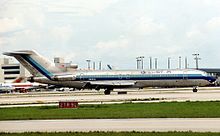Eastern Air Lines Flight 66

A Boeing 727 of Eastern Air Lines, similar to the aircraft which crashed
|
|
| Accident summary | |
|---|---|
| Date | June 24, 1975 |
| Summary | Microburst-induced wind shear |
| Site | Jamaica, New York, United States |
| Passengers | 116 |
| Crew | 8 |
| Fatalities | 113 |
| Injuries (non-fatal) | 11 |
| Survivors | 11 |
| Aircraft type | Boeing 727-225 |
| Operator | Eastern Air Lines |
| Registration | N8845E |
Eastern Air Lines Flight 66 was a regularly scheduled flight from New Orleans to New York City that crashed on June 24, 1975 while on approach to New York's John F. Kennedy International Airport, killing 113 of the 124 people on board. The crash was determined to be caused by wind shear caused by a microburst, but the airport and flight crew's failure to recognize the severe weather hazard were also contributing factors.
Eastern Air Lines Flight 66 was a regularly scheduled passenger flight from New Orleans, Louisiana's Moisant Field (since renamed Louis Armstrong New Orleans International Airport) to John F. Kennedy International Airport in Jamaica, Queens, New York. On June 24, 1975, Flight 66 was operated using a Boeing 727 trijet, registration number N8845E.
The flight departed from Moisant Field at 13:19 Eastern Daylight Time with 124 people on board, including 116 passengers and 8 crew. The flight operated from New Orleans to the New York City area without any reported difficulty.
A severe thunderstorm arrived at JFK airport just as Flight 66 was approaching the New York City area. At 15:35, Flight 66 was told to contact the JFK approach controller for instructions, and the approach controller sequenced Flight 66 into the approach pattern for JFK's runway 22L. At 15:52, the approach controller warned all incoming aircraft that the airport was experiencing "very light rain showers and haze" and zero visibility, and all approaching aircraft would need to land using instrument flight rules.
...
Wikipedia
